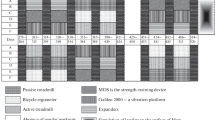Abstract
Investigations made by the World Health Organization have shown that lack of physical activity and sedentary lifestyle are among ten major causes for death and disability. Typically, studies of the negative effects of reduced physical activity and their prevention face difficulties of providing standard conditions. These issues were obviated successfully in the Mars-500 experiment on simulation of a space exploration mission. The sample of subjects consisted of six volunteers from Russia, France, Italy, and China, who were isolated in a limited space for 520 days. To prevent the negative effects of low physical activity, the volunteers performed resistive and cyclic exercises in different periods of isolation. The study was designed with two pauses in the training program. Physical performance was evaluated with an incremental loading test, maximal voluntary effort test (Russian–Austrian MDS resistive exercise system), and PWC-170 (bicycle ergometer). The level of physical performance of the subjects in this experiment never degraded to below baseline values. The proposed training system comprising different kinds of exercise ensured stability or improvement physical performance as compared with the baseline level.
Similar content being viewed by others
References
Haskell, W.L., Lee, I.M., Pate, R.R., et al., Physical activity and public health: updated recommendation for adults from the American College of Sports Medicine and the American Heart Association, Circulation, 2007, vol. 116, no. 9, pp. 1081–1093.
Jayalakshmi, M.K., Raj, P.N., Shanmukhappa, N.J., and Johncy, S.S., Effect of sedentary life style on anthropometric and cardiovascular parameters, Int. J. Biol. Med. Res., 2011, vol. 2, no. 4, pp. 846–851.
Dudchenko, Z.F. and Perfil’eva, E.N., Physical activity as a factor of the healthy life: psychological aspects, Uch. Zap. S.-Peterb. Gos. Inst. Psikhol. Sots. Raboty, 2009, vol. 11, no. 1, pp. 105–109.
O’Donovan, G., Blazevich, A.J., Boreham, C., et al., The ABC of physical activity for health: a consensus statement from the British Association of Sport and Exercise Sciences, J. Sports Sci., 2010, vol. 28, no. 6, pp. 573–593.
Rymina, T.N. and Pyatyrova, E.V., Impact of stress on seafarers during their work in the sea, Zdorov’e. Med. Ekol., Nauka, 2014, vol. 58, no. 4, pp. 103–105.
Pugachev, I.Yu., Innovations in physical training of a nuclear submarine crews, Vestn. Mordovsk. Univ., 2015, vol. 25, no. 3, pp. 31–41.
Vakoch, D.A., Psychology of Space Exploration: Contemporary Research in Historical Perspective, NASA SP-2011-4411 History Series, Washington, DC: Gov. Print. Off., 2011.
Kanas, N.A., Salnitskiy, V.P., Boyd, J.E., et al., Crewmembers and mission control personnel interactions during International Space Station missions, Aviat. Space Environ. Med., 2007, vol. 78, no. 6, pp. 601–607.
Shalupin, V.I. and Morshchinina, D.V., Improvement of the professional reliability of air traffic control civil aviation specialists by physical training, Nauch. Vestn. Mosk. Gos. Tekh. Univ. Grazhd. Aviats., 2010, no. 159, pp. 133–135.
Luria, T., Matsliah, Y., Adir, Y., et al., Effects of a prolonged submersion on bone strength and metabolism in young healthy submariners, Calcif. Tissue Int., 2010, vol. 86, no. 1, pp. 8–13.
Mikhailov, V.M., Hypokinesia as a risk factor in extreme conditions, Aviakosm. Ekol. Med., 2001, vol. 35, no. 2, pp. 26–31.
Belavý, D.L., Gast, U., Daumer, M., et al., Progressive adaptation in physical activity and neuromuscular performance during 520d confinement, PLoS One, 2013, vol. 8, no. 3, p. e60090.
Garber, C.E., Blissmer, B., Deschenes, M.R., et al., American College of Sports Medicine position stand. Quantity and quality of exercise for developing and maintaining cardiorespiratory, musculoskeletal, and neuromotor fitness in apparently healthy adults: guidance for prescribing exercise, Med. Sci. Sports Exerc., 2011, vol. 43, no. 7, pp. 1334–1359.
Lo, M.S., Lin, L.L., Yao, W.J., and Ma, M.C., Training and detraining effects of the resistance vs. endurance program on body composition, body size, and physical performance in young men, J. Strength Cond. Res., 2011, vol. 25, no. 8, pp. 2246–2254.
Streeper, T., Cavanagh, P.R., Hanson, A.M., et al., Development of an integrated countermeasure device for use in long-duration spaceflight, Acta Astronaut., 2011, vol. 68, nos. 11–12, pp. 2029–2037.
Hiruntrakul, A., Nanagara, R., Emasithi, A., and Borer, K.T., Effect of once a week endurance exercise on fitness status in sedentary subjects, J. Med. Assoc. Thailand, 2010, vol. 93, no. 9, pp. 1070–1074.
Li, C.L., Tseng, H.M., Tseng, R.F., and Lee, S.J., The effectiveness of an aerobic exercise intervention on worksite health-related physical fitness—a case in a high-tech company, Chang Gung Med. J., 2006, vol. 29, no. 1, pp. 100–106.
Taifour, A., AL-Shishani, A., Khasawneh, A., ALNawaiseh, A., and Bakeer, M., The effects of 8-weeks aerobic exercise program on blood lipids and cholesterol profile of smokers vs. non smokers, Int. Educ. Stud., 2015, vol. 8, no. 5, pp. 131–138.
Vats, U. and Patra, P., Effect of moderate intensity aerobic exercises on vital capacity and quality of life on asymptomatic subjects with sedentary lifestyle, Int. J. Med. Health Sci., 2015, vol. 4, no. 1, pp. 24–28.
Alkner, B.A., Berg, H.E., Kozlovskaya, I., et al., Effects of strength training, using a gravity-independent exercise system, performed during 110 days of simulated space station confinement, Eur. J. Appl. Physiol., 2003, vol. 90, nos. 1–2, pp. 44–49.
Kozlovskaya, I.B., Suvorov, A.V., Shpakov, A.V., et al., Efficiency of countermeasure means against the negative impact of hypodynamia during the 105-day experiment simulated interplanetary space flight, XXI S”ezd Fiziologicheskogo obshchestva im. I.P. Pavlova, Tezisy dokladov (The XXI Congr. of Pavlov Physiological Society, Abstracts of Papers), Moscow, 2010.
Author information
Authors and Affiliations
Corresponding author
Additional information
Original Russian Text © E.V. Fomina, K.V. Uskov, 2016, published in Aviakosmicheskaya i Ekologicheskaya Meditsina, 2016, Vol. 50, No. 5, pp. 47–55.
Rights and permissions
About this article
Cite this article
Fomina, E.V., Uskov, K.V. Effectiveness of Different Training Programs for Physical Performance Maintenance under the Condition of Low Motor Activity. Hum Physiol 43, 818–825 (2017). https://doi.org/10.1134/S0362119717070076
Received:
Published:
Issue Date:
DOI: https://doi.org/10.1134/S0362119717070076




